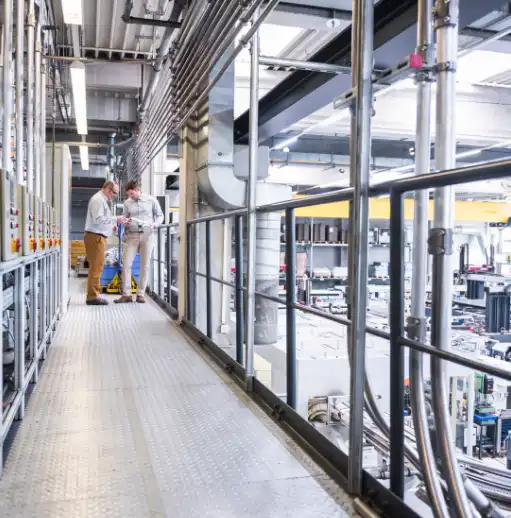
Key takeaways
- Maintenance management optimizes resources to keep assets reliable and safe. The goal is to reduce costs, minimize downtime, extend asset lifecycles, and maintain compliance while ensuring a safe work environment.
- Different strategies suit different assets. Options include run-to-failure, preventive, condition-based, and reliability-centered maintenance, each with its own benefits and resource requirements.
- Effective programs integrate planning, scheduling, work orders, inventory control, and reporting. Coordinated activities ensure maintenance is performed efficiently and improvements are based on real data.
Maintenance management efficiency plays a large part in organizational success. With the right maintenance processes and policies, you can extend the life of your assets, reduce the risk of asset failures, help you control your costs, and improve workplace safety. But with so many moving parts, you need to carefully plan which strategies to implement and how best to allocate resources.
What is maintenance management?
Maintenance management is the process of maintaining your assets and resources efficiently and effectively. The main objective is to minimize the amount of money, time, and resources you put into maintenance processes while still ensuring that everything stays up and running. Instead of being surprised by unexpected failures that disrupt workflows, you have tighter control and more predictability.
Traditionally, maintenance management was a chaotic collection of processes held together by handwritten notes. But with a modern unified platform, you can combine automated data capture, streamlined workflows, and inventory control to keep assets and equipment online.
But there’s no perfect, one-size-fits-all program. Instead, you need to customize your maintenance management program to best support specific departmental and overall organizational goals.
Why is maintenance management important?
The efficiency of your maintenance plays a big part in your success. For example, by properly maintaining your assets and equipment in a manufacturing setting, you keep production stable, reduce the likelihood of unplanned downtime, improve reliability and availability, and maximize your product quality.
Poor maintenance management leads to spikes in breakdowns, cost of repairs, delayed shipments, and lost revenue. It can also create workplace safety hazards.
What is the purpose of maintenance management?
Regardless of the type of facility you’re looking after, the main objectives of maintenance management are:
- Extending asset life cycles
- Reducing downtime
- Controlling costs
- Maintaining regulatory compliance
- Ensuring employee safety
- Refining policies and procedures
Collectively, achieving these goals delivers a productive facility with a strong return on investment (ROI).
What are the different types of maintenance management?
There are four key maintenance management strategies you can use, either in combination or independently. The most appropriate strategy for any specific asset or piece of equipment depends on several factors, including age, repair and maintenance histories, and criticality.
Run-to-failure, reactive maintenance
Running an asset until it fails and then replacing it is a legitimate maintenance management strategy when there’s no safety risks and a minimal impact on production. And with this strategy, there’s no requirement for your team to perform any maintenance until that failure occurs. However, when it does, you need to have the right replacements already on hand.
Proactive preventive maintenance
Based on the adage that “an ounce of prevention is better than a pound of cure,” here you’re scheduling inspections and regular maintenance, so you can take care of the smaller tasks such as adjustments, cleaning, lubrication, and simple repairs to keep your assets in good working order and reduce the likelihood of unscheduled downtime.
With newer assets and equipment, it makes the most sense to schedule your maintenance around the manufacturer’s recommendations. However, as your assets age, your technicians develop insights into the more common problems, so they know best how and when to check for early signs of trouble.
Preventive maintenance delivers increased efficiency. Because you’re planning everything in advance, you can line up the required parts and schedule the work outside of peak times. In manufacturing, that means outside of important production runs. For maintenance in an office setting, you’re not sending in a team to work on the HVAC during the annual shareholders meeting.
Condition-based maintenance
With this strategy, you use monitoring tools to determine when the best time to perform maintenance on your assets is based on their condition. The idea is to always be on the lookout for signs of a problem and to intervene before it becomes a serious issue. For example, your maintenance team might use vibration analysis to check when things fall below or jump above certain parameters. When they do, you take the equipment offline, inspect it, and repair it if required.
An advantage of condition-based maintenance is that the sensors can inspect the asset while it’s still running, and you’re only alerted if there’s a problem. That allows you to reduce the frequency of inspections and ensure that you only perform maintenance tasks when necessary. There are more upfront costs because of the monitoring equipment and additional training your techs may need to set up and maintain it, but those can be offset over time.
Reliability-centered maintenance
Here, you create a specific maintenance strategy for each asset optimized to maintain productivity using the most cost-effective maintenance techniques. Reliability-centered maintenance takes time to implement because you must analyze each asset individually. You can also end up with as many different maintenance plans as you have assets, so you’ll need an experienced, versatile, and highly trained team of techs to implement them.
What are the different activities involved in maintenance management?
There are many different activities that you must coordinate and plan to create a seamless maintenance management program.
Although you don’t need to plan and schedule all your maintenance, it is the cornerstone of any proactive maintenance management strategy. You must prioritize the maintenance work and organize it so that it can be completed efficiently by your technicians.
As part of your maintenance planning, you need to decide:
- What maintenance tasks to do
- Who should perform them
- What tools and parts they need
Once you’ve planned the work, your next job is to schedule it. Some maintenance tasks are urgent, while others can be scheduled for later. Regularly occurring tasks such as inspections can be scheduled weeks, months, or even years in advance.
Work order management is another important aspect of your maintenance management. A work order is your primary channel of communication for maintenance work and outlines all the information about a maintenance task and the process your techs must follow. As part of your maintenance management program, you must define how work orders are created, processed, and completed, including how they’re prioritized, documented, and assigned.
Maintenance request management is another vital part of your maintenance management strategy. Although most of your organization’s maintenance tasks are identified by your maintenance team, requests for maintenance assistance can also come from other departments and employees. You need to decide how those requests will be reviewed and approved before becoming work orders.
Your maintenance, repair, and operations (MRO) inventory management is another element to consider. This includes all items you use in your maintenance work, from spare parts and tools to safety equipment, personal protective equipment, chemicals, and cleaners. You need to think about how you procure, store, and replenish your MRO inventory to make sure that the right equipment is available at the right time.
Finally, as with all types of management, you need to think about your reporting. Producing maintenance management reports can provide you with information and insights about every aspect of your maintenance operation so you can see what you’re doing well and identify areas where improvements can be made.
Frequently asked questions
The main objective is to maintain assets and equipment efficiently, using the least amount of time, money, and resources while maximizing uptime, safety, and asset longevity.
It depends on the asset’s criticality, age, maintenance history, and operational impact. Some assets may benefit from preventive maintenance, while others are better suited to condition-based or run-to-failure approaches.
Without the right parts, tools, and safety equipment on hand, even well-planned maintenance schedules can be delayed, leading to increased downtime and potential safety risks.








